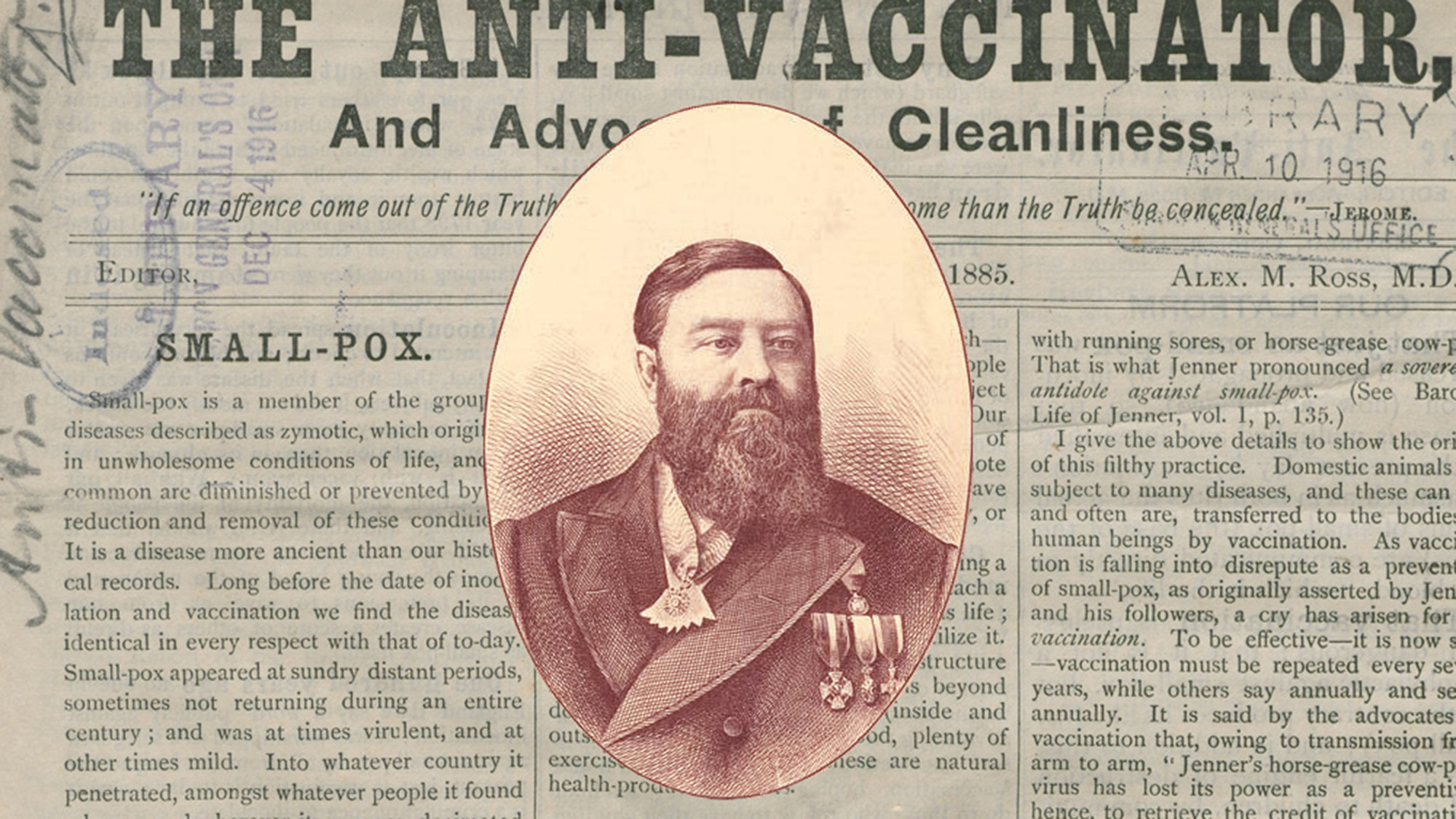

This article was originally featured on MIT Press Reader.
This article is excerpted from Sabrina Sholts’s book “The Human Disease: How We Create Pandemics, from Our Bodies to Our Beliefs.“
“VACCINATE! VACCINATE!! VACCINATE!!! THERE’S MONEY IN IT!!! TWENTY THOUSAND VICTIMS!!! will be Vaccinated within the next ten days in this City under the present ALARM!!! That will put $10,000 into the pockets of the Medical Profession.” In case all the exclamation points and capitalized letters didn’t do the trick, Alexander Milton Ross embellished his poster with a large drawing of a police officer restraining a mother while Death vaccinated her child. It was terrifying, no doubt. For extra emphasis, the police officer held a piece of paper that read “Vaccination for the Jenner-ation of Disease,” a reference to the English physician Edward Jenner, who developed and promoted vaccination.
In 1885, Canada had no greater adversary of smallpox vaccination than Ross, an Anglo-Canadian physician and naturalist whose medical training was informed by the sanitary movement of the 19th century. Opposed to the germ theory emerging in Europe (that same year, Louis Pasteur’s rabies vaccine was announced to the world), Ross believed that smallpox was a filth disease and its only antidote was cleanliness. And though it’s true that smallpox could spread through soiled fabrics used by smallpox patients (such as bedding and clothing), its primary route of transmission was virus-laden respiratory droplets. The real danger thus lay in close and prolonged contact with smallpox patients, independent of how clean the setting was.
Vaccination, in Ross’s mind, was poisonous. He wanted everyone to know it too. Besides papering the city of Montreal with antivaccination posters and pamphlets, writing letters to newspapers and professional journals, and founding a magazine called the Anti-Vaccinator, he formed the Canadian Anti-Vaccination League as part of an international antivaccination crusade. “Though Police and the Profession cry Vaccinate! Vaccinate!! Vaccinate!!! and people in thousands follow their blind leaders, — I still say, DON’T,” Ross urged in a circular that he distributed throughout the city.
Ross believed that smallpox was a filth disease and its only antidote was cleanliness.
At the time, Montreal was struggling to fight off the largest epidemic of smallpox that it would ever face. For almost a century, smallpox vaccination had been widely used to prevent the disease, but many of the city’s inhabitants had refused the procedure.
Some of the holdouts were surely persuaded by Ross and his English-only propaganda. But most of the unvaccinated population and therefore the bulk of the cases consisted of French Canadians. To convince them of the evils of vaccination, French Canadian physician Joseph Emery Coderre formed the first Canadian antivaccination society in Montreal and published numerous antivaccination pamphlets in French in the 1870s. His ardent antivaccination views fed the fervor of protesters who attacked the city council in 1875, halting efforts to enact mandatory smallpox vaccination in Montreal and leaving the city vulnerable to devastating disease 10 years later. When compulsory vaccination was attempted again in 1885, the riot was even bigger. Shortly thereafter, Coderre and colleagues created an antivaccination journal, L’Antivaccinateur canadien-français, the Francophone counterpart to Ross’s magazine.

The misinformation promoted by Ross, Coderre, and their contemporaries should be familiar to anyone with a social media account in the 21st century. First off, they downplayed the threat of the epidemic in Montreal. Francophone newspapers wrote little about it, except to dismiss the panic, while Ross stressed in one of his pamphlets, “CAUTION. Do not be alarmed by the smallpox.” Simultaneously, they insisted that vaccination was the true danger. In the Anti-Vaccinator, Ross explained that vaccination didn’t prevent smallpox and actually infected people with the smallpox virus, along with other equally lethal pathogens. Coderre likewise insisted that victims of vaccination were everywhere. His writings included pages of individuals whom he believed were sickened or killed by the vaccine, either from contracting smallpox or some other malady such as gangrene and syphilis.
And then, of course, they spouted conspiracy theories. Provaccination doctors were accused of profiting from the practice, as Ross broadcast in his poster. One French Canadian doctor, in an open letter to Coderre published by the medical journal L’Union Médicale du Canada in 1875, laid out the same charge. He also perceived another conspiracy among English physicians in particular, attributing their advocacy of the smallpox vaccine to nationalistic conflicts of interest given that English physician Jenner was associated with it. Coderre replied in agreement, affirming that English doctors and public vaccinators practiced vaccination par intérêt — purely out of self-interest. These beliefs were consistent with a general distrust of the Anglophone elite, whose vaccines were seen as both poisoning and punishing the French Canadian community, which mostly lived in overcrowded tenements in the poorest quarters of the city.
Their arguments are reminiscent of misinformation during subsequent epidemics and pandemics, all the way up to the present. It’s also noteworthy that while Ross thought sanitation was the answer to smallpox, Francophone newspapers printed recipes for at-home remedies, such as buckwheat root or mixtures of zinc sulfate, digitalis, and sugar. (A cure was never found for smallpox before its eradication, and treatments generally consisted of cleaning the wounds and easing the pain of the ill.) These ideas are akin to the popularization in the United States of non-FDA-approved treatments for COVID-19, such as ivermectin (an antiparasitic agent used to treat patients with certain worm infections and head lice) and hydroxychloroquine (a medication used for malaria and autoimmune conditions such as lupus and rheumatoid arthritis), which many people learned about through the internet, social media, and celebrity testimonials. Despite early hopes, neither of them turned out to be effective for preventing or treating COVID-19. But without any specific treatments for COVID-19 until long into the pandemic, it’s not surprising that some patients opted to take risks with these unproven remedies rather than heed public health warnings against them. Some physicians even participated in misinformation about the efficacy of these drugs and continued to prescribe them for COVID-19. And although many studies haven’t observed that ivermectin and hydroxychloroquine cause serious adverse effects in COVID-19 patients, they can still be dangerous if the patients forgo evidence-based COVID-19 treatments or vaccination against SARS-CoV-2 as a result of using them, as editors at the Journal of the American Medical Association pointed out last year.
To be fair, smallpox vaccination was far from perfectly safe in the late 19th century. Even Jenner himself couldn’t explain how his vaccine worked, and some methods (such as passing infectious material directly from the arm of a vaccinated person to an unvaccinated one) undoubtedly had the potential to introduce other infections. There were also some cases where children may have died as a result of faulty vaccine preparations. Furthermore, even if the vaccination was successful, it didn’t guarantee complete or lifelong immunity. Antivaccinationists, though, were incorrect about the risks and effects of the vaccine. And their dishonesty, at least in the case of Ross, raised questions about their own motives.
One State Board of Health report called him “a monster in human form who desired that a most terrible disease should decimate his patrons, that he might grow fat on their putrid bodies.”
Ross, the bombastic pamphleteer, was apparently a hypocrite at heart. In October 1885, while the smallpox epidemic was still raging in Montreal, he boarded a train to Toronto. As reported afterward by the Gazette, a medical inspector at the Ontario border asked Ross to show proof of recent smallpox vaccination, either in the form of a certificate or scar. It was a standard policy for travelers, but Ross tried his best to get out of it. Then when he couldn’t produce a certificate, he reluctantly took off his coat, rolled off his sleeve, and revealed “three perfect vaccination marks” on his arm. One of them was relatively fresh, and the others were from infancy and childhood, according to Ross. The article about the incident offered little by way of commentary, except to note the long history of doctors who believed in the efficacy of vaccination but opposed the practice since they would lose a source of revenue if smallpox declined. (Similarly, during the COVID-19 pandemic, the Fox News channel was a top broadcaster of vaccine skepticism in the United States, even though nearly all of the corporation’s employees were vaccinated.)
The news about Ross reached the United States, where it was met with outrage among the public health community. One State Board of Health report called him “a monster in human form who desired that a most terrible disease should decimate his patrons, that he might grow fat on their putrid bodies.”
By the end of the smallpox epidemic in Montreal in 1886, more than 3,200 people had died from the disease. The city lost almost 2 percent of its total population in 1885 alone, and more than 3 percent of its French Canadian community. Most of them were children. There were numerous blunders that helped the disease spread, as historian Michael Bliss recounts in his book “Plague: How Smallpox Devastated Montreal,” and the large population of unvaccinated children created by fear and ignorance was a major factor. Every one of the deaths could have been prevented, Bliss emphasizes. Unfortunately, it wasn’t until the disease ran out of unvaccinated or otherwise vulnerable hosts that the epidemic finally waned.
Misinformation about diseases is a timeless human challenge. Some opinions offered about the antivaccination riot in Montreal, such as in a New York Times editorial in 1875, ring a bell 150 years later. With shock that anyone would harbor such an absurd preconception against vaccination, a triumph of modern medicine, the editorial lamented that “in spite of all our boasted progress, curious revelations of popular ignorance and superstition are constantly showing us how little progress has been made.” But after laying blame on the fortune tellers in large cities, the quacks in medicine that flourished everywhere, and even the scientific research and scholarly writings that went above the heads of the public, there was still optimism: “When knowledge is more evenly distributed, there will be less of this fantastic and ignorant prejudice.”
Evenly distributed knowledge? That sounds a lot like the internet to me.
Sabrina Sholts is the curator of biological anthropology at the Smithsonian’s National Museum of Natural History, where she developed the major exhibit “Outbreak: Epidemics in a Connected World.” She is the author of “The Human Disease,” from which this article is excerpted.
